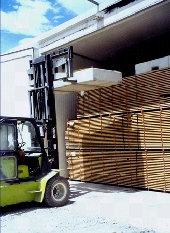Abstract - G. Vaughn, MSc, Energy Management
Exergy Analysis of a Wood Stack During Drying
Gareth Vaughan - 2000
The configuration of a dehumidifier wood drying kiln that results in the lowest total expenditure of energy is desirable for economic and environmental reasons. The exergy destruction rate is equal to the minimum work required to complete a process, in this case the drying of a wood stack. The exergy destruction within the wood stack is a significant contribution to the total exergy destruction rate for the kiln.
 This thesis presents a computational model designed to examine the variation in the air-stream properties with distance. The control volume method issued as the basis for the model. This method involves the evaluation of the governing equations (the energy, mass, momentum balance equations and an empirical expression for the pressure drop) for the control volume. For each control volume the air-stream conditions (pressure, temperature, relative humidity and velocity) at the exit are the unknown variables. Broyden's method is used to find the values of the unknowns to solve the balance equations and these values become the input variables for the subsequent control volume. This process is repeated until the air stream conditions at the outlet to the stack are known. The principles that underpin this model are discussed in depth in the body of the thesis.
This thesis presents a computational model designed to examine the variation in the air-stream properties with distance. The control volume method issued as the basis for the model. This method involves the evaluation of the governing equations (the energy, mass, momentum balance equations and an empirical expression for the pressure drop) for the control volume. For each control volume the air-stream conditions (pressure, temperature, relative humidity and velocity) at the exit are the unknown variables. Broyden's method is used to find the values of the unknowns to solve the balance equations and these values become the input variables for the subsequent control volume. This process is repeated until the air stream conditions at the outlet to the stack are known. The principles that underpin this model are discussed in depth in the body of the thesis.
A wood stack consists of both a central section and one of several different types of side section, each of which must be modeled separately. Only the constant rate period of the drying process is considered here.
Changes in the air-stream properties due to variations in the stack parameters and in the type of side stack are examined. The rate of transfer of heat, mass and momentum and the factors that affect these are discussed.
From the information for the air-stream properties in the stack the rate of exergy destruction and entropy generation are found. These rates are linked by the Gouy-Stodola theorem and so the two values can be compared.
It is found that the heat transfer component of the entropy generation rate is the only significant term in the entropy generation rate, except at low heat transfer rates. The mass transfer contribution is negligible for all conditions shown and the momentum term is negligible term for all conditions except where the velocity is high or when the heat transfer in greater rates of entropy generation.
The sudden contractions and expansions through which the air-stream flows as it enters and exits the stack are accounted for in the model. It is found that exergy destruction due to these features is small in comparison to the exergy destruction due to heat and mass transfer within the main body of the stack.

